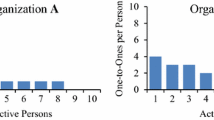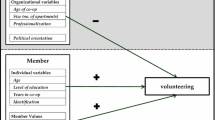Abstract
Lack of participation in voluntary associations and the associated issues of why people do or do not participate are major areas of interest in the research literature concerning citizen participation. The present study used three types of variables (demographic, social psychological, and costs/benefits) to investigate the characteristics of participants and nonparticipants in neighborhood-type organizations in the United States and Israel. Findings from analysis of the demographic variables show some cross-cultural similarities (including a surprising lack of race/ethnic and education differences between participants and nonparticipants). There were striking cross-cultural similarities using the social psychological variables. The data from the Israel sample provide important information on the costs and benefits of participation. A discriminant analysis points to the predictive strength of social psychological and cost/benefit variables in comparison to demographic variables. Implications of these results for explanatory and predictive purposes are discussed.
Similar content being viewed by others
References
Agger, R. E., M. N. Goldstein, andS. A. Pearl 1961 “Political cynicism: Measurement and meaning.” Journal of Politics 23:477–506.
Ahlbrandt, R. S. andJ. V. Cunningham 1979 A New Public Policy for Neighborhood Preservation. New York: Praeger.
Ahlbrandt, R. S. andP. Brophy 1975 Neighborhood Revitalization: Theory and Practice. Lexington, MA: Lexington.
Alford, R. R. andH. M. Scoble 1968 “Community leadership: Education and political behavior.” American Sociological Review 33:259–272.
Babchuk, N. and R. Thompson 1962 “The voluntary association of Negroes.” American Sociological Review 27.
Bachrach, K. andA. Zautra 1985 “Coping with a community stressor: The threat of a hazardous waste facility.” Journal of Health and Social Behavior 26:127–141.
Bronfenbrenner, U. 1960 “Personality and participation: The case of the vanishing variables.” Journal of Social Issues 16:54–63.
Campbell, A., G. Gurin, andW. Miller 1954 The Voter Decides. Evanston, IL: Row Peterson.
Carr, T., M. Dixon, andR. Ogles 1976 “Perceptions of community life which distinguish between participants and nonparticipants in a neighborhood self-help organization.” American Journal of Community Psychology 4:357–366.
Churchman, A. 1987 “Can resident participation in neighborhood rehabilitation programs succeed? Israel's Project Renewal through a comparative perspective.” In I. Altman and A. Wandersman (eds.), Neighborhood and Community Environments. New York: Plenum.
Clark, P. B. andJ. Q. Wilson 1961 “Incentive systems: A theory of organizations.” Administrative Science Quarterly 6:129–166.
Cohen, S. 1976 “Factors influencing citizen participation and nonparticipation in a community design project.” Masters thesis, Cornell University.
Cook, J. 1983 “Citizen response in a neighborhood under threat.” American Journal of Community Psychology 11:459–471.
Coopersmith, S. 1967 The Antecedents of Self-esteem. San Francisco, CA: W. H. Freeman.
Edwards, J. N. andR. P. White 1980 “Predictors of social participation: Apparent or real?” Journal of Voluntary Action Research 9:60–73.
Emmons, D. 1979 Neighborhood Activities and Community Organizations: A Critical Review of the Literature. Evanston, IL: Northwestern University, Center for Urban Affairs.
1983 “A psychological perspective on neighborhood conservation.” In N. R. Feimer and E. S. Geller (eds.), Environmental Psychology: Directions and Perspectives. New York: Praeger.
1984 “Cognitive social learning and participation in community development.” American Journal of Community Psychology 12:689–708.
Florin, P., R. Friedmann, A. Wandersman, and R. Meier 1987 “Cognitive social learning variables and behavior: Cross cultural similarities in person x situation behavior.” Manuscript.
Friedmann, R., P. Florin, A. Wandersman, and R. Meier 1987 “Local action on behalf of local collectives in the United States and Israel: How different are leaders from members in voluntary associations.” Manuscript.
Gittell, M. 1980 Limits of Citizen Participation: The Decline of Community Organizations. Beverly Hills, CA: Sage.
Gough, H. G. 1952 “Predicting social participation.” Journal of Social Psychology 35:227–233.
Gurin, P., G. Gurin, R. Lao, andM. Beattie 1969 “Internal-external control in the motivational dynamics of Negro youth.” Journal of Social Issues 25:29–54.
Henig, J. 1982 Neighborhood Mobilization: Redevelopment and Response. New Brunswick, NJ: Rutgers University Press.
Hyman, H. andC. Wright 1971 “Trends in voluntary association membership of American adults: Replication based on secondary analysis of national sample surveys.” American Sociological Review 36:191–206.
Knoke, D. andJ. R. Woods 1981 Organized for Action: Commitment in Voluntary Associations. New Brunswick, NJ: Rutgers University Press.
Langton, S., ed. 1978 Citizen Participation in America. Lexington, MA: Heath.
Lavrakas, P. J. andE. J. Herz 1982 “Citizen participation in neighborhood crime prevention.” Criminology 20:479–498.
Litwak, E. 1961 “Voluntary associations and neighborhood cohesion.” American Sociological Review 26:258–271.
Milbrath, L. W. 1965 Political Participation: How and Why Do People Get Involved in Politics? Chicago: Rand McNally.
Moe, T. M. 1980 The Organization of Interests: Incentives and the Internal Dynamics of Political Interest Groups. Chicago: The University of Chicago Press.
Oliver, P. 1984 “If you don't do it, nobody else will: Active and token contributors to local collective action.” American Sociological Review 49:601–610.
Olson, M. 1965 The Logic of Collective Action. Cambridge, MA: Harvard University Press.
Orum, A. M. 1966 “A reappraisal of the social and political participation of the Negroes.” American Journal of Sociology 72:32–46.
Parkum, K. andV. Parkum 1980 “Citizen participation in community planning and decision making.” In D. H. Smith (ed.), Participation in Social and Political Activities. San Francisco: Jossey-Bass.
Peattie, L. 1968 “Reflections on advocacy planning.” Journal of the American Institute of Planners 34:80–88.
Piven, F. 1968 “Participation of residents in neighborhood community-action programs.” In H. B. Spiegel (ed.), Citizen Participation in Urban Development, vol. 1. Washington, DC: NTL Institute.
Prestby, J. E. 1984 “Leaders and members in voluntary organizations.” Working paper, Department of Psychology, University of South Carolina.
Rich, R. C. 1980 “The dynamics of leadership in neighborhood organizations.” Social Science Quarterly 60:570–587.
Sanger, P. andH. Alker 1972 “Dimensions of internal-external locus of control and the Women's Liberation movement.” Journal of Social Issues 28:115–129.
Skogan, W. G. andM. Maxfield 1981 Coping with Crime: Individual and Neighborhood Reactions. Beverly Hills, CA: Sage.
1975 “Voluntary action and voluntary groups.” In A. Inkeles, J. Coleman, and N. Smelser (eds.), Annual Review of Sociology, vol. 1. Palo Alto, CA: Annual Reviews.
1985 “Volunteerism: Attracting volunteers and staffing shrinking programs.” In G. Tobin (ed.), Social Planning and Human Service Delivery in the Voluntary Sector. Westport, CT: Greenwood.
Stone, R. A. andA. G. Levine 1985 “Reactions to collective stress: Correlates of active citizen participation at Love Canal.” In A. Wandersman and R. Hess (eds.), Beyond the Individual: Environmental Approaches and Prevention. New York: Haworth.
Tomeh, A. K. 1974 “Formal voluntary organizations: Participation correlates and interrelationships.” Sociological Inquiry 43:89–122.
Triandis, H. C. andR. W. Brislin 1984 “Cross-cultural psychology.” American Psychologist 39:1006–1016.
Uzzell, L. 1980 “Conflicting explanations of participatory group membership.” Journal of Voluntary Action Research 9:203–210.
Vassar, S. 1978 “Community participation in a metropolitan area: An analysis of the characteristics of participants.” Ph.D. dissertation, University of Illinois at Chicago.
Verba, S. andN. Nie 1972 Participation in America: Political Democracy and Social Equality. New York: Harper and Row.
Wandersman, A. 1978 “Participation in block organizations.” National Science Foundation grant.
1981 “A framework of participation in community organizations.” Journal of Applied Behavioral Science 17:27–58.
Warren, R. 1963 The Community in America. Chicago: Rand McNally.
Widmer, C. 1984 “An incentive model of citizen participation applied to a study of human service agency boards of directors.” Ph.D. dissertation, Cornell University.
Williams, J., N. Babchuk, andD. Johnson 1973 “Voluntary associations and minority status: A comparative analysis of Anglos, Blacks, and Mexican Americans.” American Sociological Review 38:637–646.
Williams, J. andS. Ortega 1986 “The multidimensionality of joining.” Journal of Voluntary Action Research 15:35–44.
Author information
Authors and Affiliations
Rights and permissions
About this article
Cite this article
Wandersman, A., Florin, P., Friedmann, R. et al. Who participates, who does not, and why? An analysis of voluntary neighborhood organizations in the United States and Israel. Sociol Forum 2, 534–555 (1987). https://doi.org/10.1007/BF01106625
Published:
Issue Date:
DOI: https://doi.org/10.1007/BF01106625




